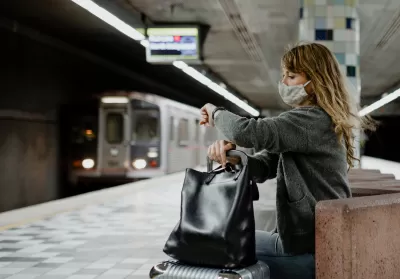Safety and harassment are commonly cited reasons passengers, particularly women and girls, avoid public transit.

“Street harassment is a common phenomenon that many public-transit riders, but especially women and girls, experience on buses and trains, in stations and at bus stops, as they travel between their homes, jobs, schools, events, and recreational activities.” Gabrielle Gurley notes this stark fact at the top of an article in The American Prospect.
In an effort to reduce harassment and make transit safer for women and girls, California legislators passed a law calling for a survey of transit riders’ experiences with harassment, and a second law requiring major transit agencies to collect passenger data on harassment.
In response to user surveys and data about harassment, San Francisco’s BART and Los Angeles Metro launched transit ambassador programs that staff transit stations with unarmed security personnel. “For its part, BART started running shorter trains. Fewer cars with more people on each car helps people feel safer. After this change, the agency has had fewer incidents involving police.”
The agencies are also including zero-tolerance language in their policies and conducting outreach about harassment and available resources, such as emergency call buttons that some passengers are unaware of.
According to the article, “LA Metro saw its highest ridership increases last year after its high-profile moves to offer information services and deploy more security officers, transit ambassadors, crisis intervention specialists, and workers to handle people suffering from drug abuse and homelessness. The agency also made numerous facility safety improvements, adding new lighting, additional call boxes, station music, and modified entrances.”
FULL STORY: California Public-Transit Agencies Confront Rider Harassment

Planetizen Federal Action Tracker
A weekly monitor of how Trump’s orders and actions are impacting planners and planning in America.

DARTSpace Platform Streamlines Dallas TOD Application Process
The Dallas transit agency hopes a shorter permitting timeline will boost transit-oriented development around rail stations.

Four Reasons Urban Planners Can’t Ignore AI
It’s no longer a question of whether AI will shape planning, but how. That how is up to us.

Amtrak’s Borealis Exceeds First Year Ridership Expectations
205,800 passengers have boarded the St. Paul to Chicago line, well above initial MDOT projections.

Study: 4% of Truckers Lack a Valid Commercial License
Over 56% of inspected trucks had other violations.

Chicago Judge Orders Thousands of Accessible Ped Signals
Only 3% of the city's crossing signals are currently accessible to blind pedestrians.
Urban Design for Planners 1: Software Tools
This six-course series explores essential urban design concepts using open source software and equips planners with the tools they need to participate fully in the urban design process.
Planning for Universal Design
Learn the tools for implementing Universal Design in planning regulations.
City of Mt Shasta
City of Camden Redevelopment Agency
City of Astoria
Transportation Research & Education Center (TREC) at Portland State University
US High Speed Rail Association
City of Camden Redevelopment Agency
Municipality of Princeton (NJ)





























